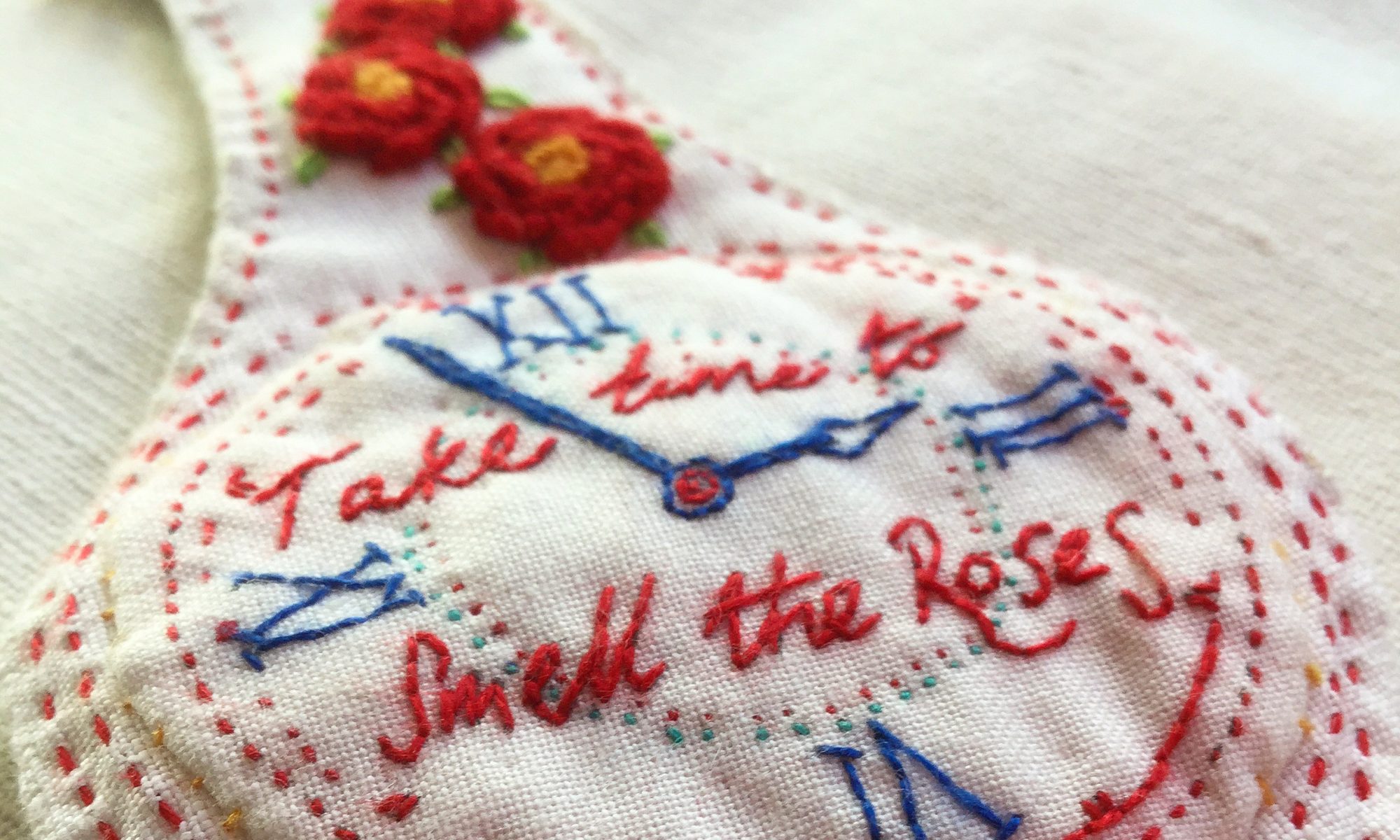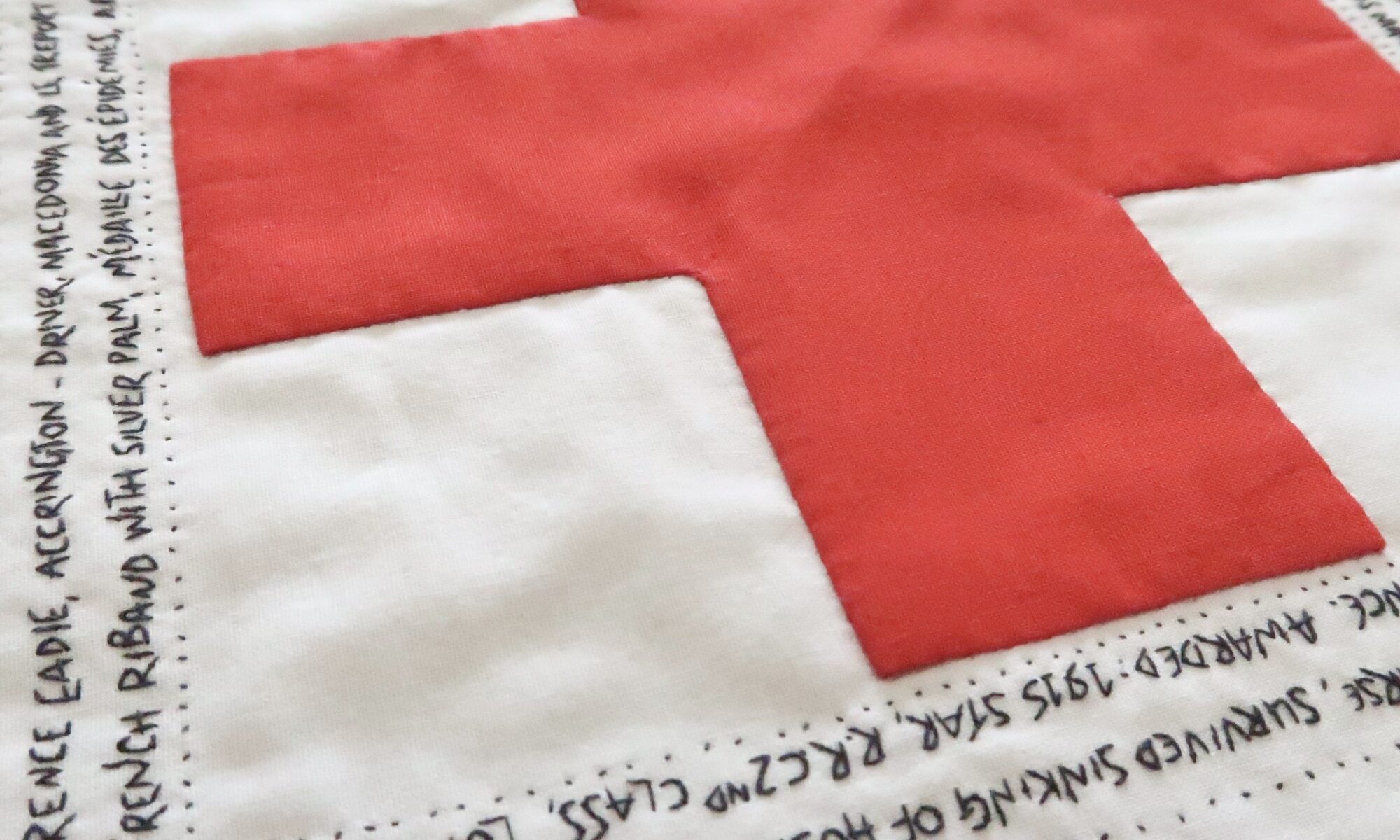My latest hand embroidered artwork ‘Blood Sweat and Tears’, was created as a nod to the members of the Red Cross who dedicate their lives to the care and protection of others in times of need.
This piece is a window into the lives of five women who did just that between 1914-1918 and came from an area local to Accrington in Lancashire.
The central motif was inspired by Red Cross nurses’ aprons. I chose a red cotton cloth, very close in shade to the original, and hand appliquéd it centrally onto the background.
Size 30 x 30cm. Hand embroidered text with vintage Sylko threads onto cotton cloth.
Blood, Sweat and Tears was created as a companion piece for ‘Accrington Pals’

Research for Blood, Sweat and Tears
My research of the British Red Cross archives took several months to complete. I discovered Voluntary Aid Detachment (VAD) records for both men and women, but it was the stories of women in wartime that really resonated with me.
As men were called away to war, it fell upon the women to fill the gaps in the workforce – which indirectly was a catalyst for the emancipation for women.
Women from all walks of life volunteered.
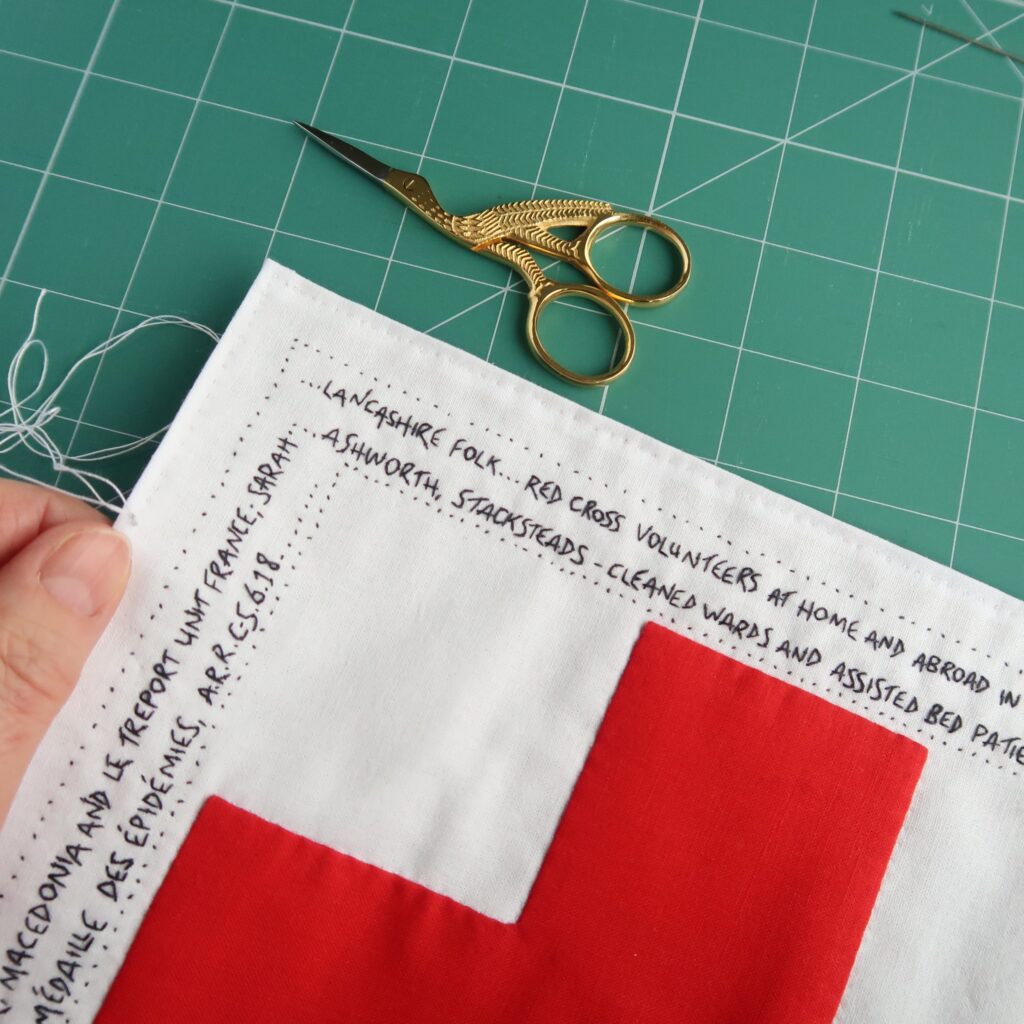
Five women from Lancashire
Blood, Sweat and Tears focusses on five women who lived in the same area within Lancashire. The following includes additional research that creates a window into their wartime experiences.
Alice Ogden Adcock
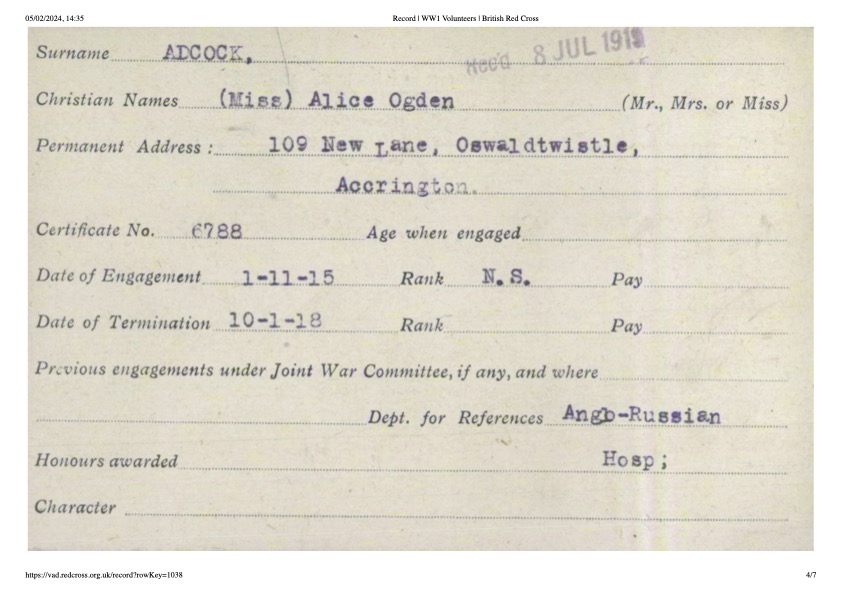
Alice Ogden Adcock from Accrington worked as a Nurse from 1915-1918 at the Anglo-Russian Hospital within the Dimitri Palace, Petrograd, Russia (now renamed the Beloselsky-Belozersky Palace) nursing Russian soldiers at the hospital and field stations.
The hospital was established, under the patronage of HM Queen Alexandra, in August 1915 as a “British gift to our Russian allies” and was once visited by the Tsarina and her daughters.
Marion Ramsbottom
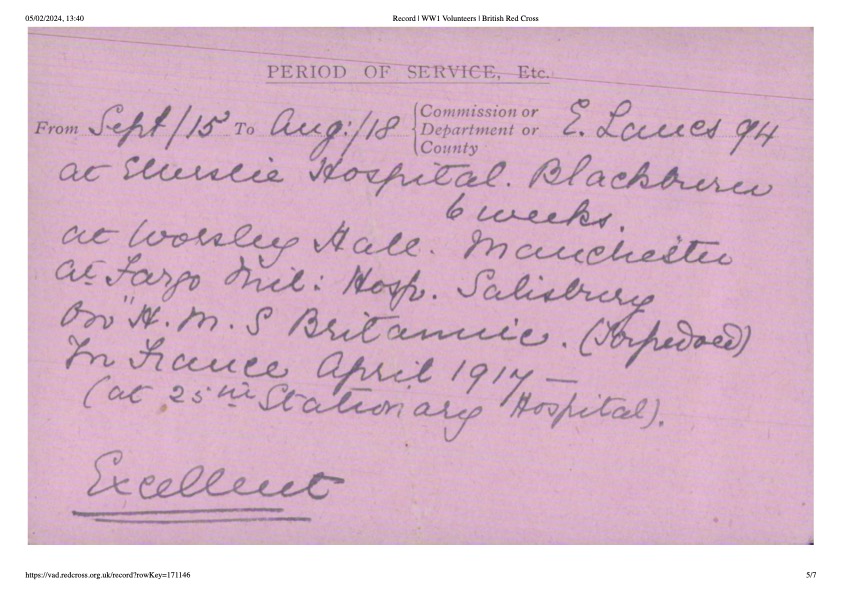
Marion Ramsbottom from Clitheroe worked as a Nurse at Ellerslie Auxilary Hospital in Blackburn, then at Worsley Hall in Manchester and Fargo Military Hospital in Salisbury. In 1916 she survived the sinking of hospital ship H.M.S. Britannic off the coast of Greece, then in 1917 continued her service at the 25th Stationary Hospital in Rouen, France.
Ellerslie Auxiliary Hospital opened on the 28th of October 1914 at Ellerslie on Bury Fold Lane, Darwen. It provided 28 beds on opening which was increased to 41 in August 1915, an annexe was opened to increase the capacity to 50 in April 1916. In July a second annexe opened at Staveleigh, bringing the total number of beds to 75. In June 1917 the hospital moved to the newly built Public Halls in Northgate, Blackburn allowing capacity to be increased to 120.
Worsley Hall, a Gothic-style mansion, was the home to the Earl of Ellesmere. At the outbreak of war, the 4th Earl and his wife lent the Hall to the British Red Cross Society as an Auxiliary Home Hospital for wounded soldiers. The hospital was fitted out to accommodate up to 132 patients, and 884 patients were treated there in the 1st year alone. The large lofty rooms of the Hall were converted into wards, sitting rooms and dining rooms, and the gardens and boating lake were used for recreation. The greenhouses and kitchen gardens provided patients with fruit and vegetables and at Christmas, the Hospital was decorated with evergreens and a fir tree.
A training camp for the artillery was established at Fargo on the Salisbury Plain in 1904, and grew to include medical units. In July 1914, just before the outbreak of the war, the Royal Army Medical Corps started work on the construction of the 1,200 bed Fargo Military Hospital. This hospital’s location was very close to many of the camps used by the Australians in England during the war. As a result many Australians would have been treated at Fargo for sickness and also accidents, many incurred in training.
His Majesty’s Hospital Ship Britannic was the third and final vessel of the White Star Line’s Olympic class of steamships and the second White Star ship to bear the name Britannic. She was the youngest sister of the RMS Olympic and the RMS Titanic and was intended to enter service as a transatlantic passenger liner. On the morning of 21 November 1916 she hit a naval mine of the Imperial German Navy near the Greek island of Kea and sank 55 minutes later, killing 30 people. There were 1,066 people on board; the 1,036 survivors were rescued from the water and lifeboats. Britannic was the largest ship lost in the First World War.
Florence Eadie

Florence Eadie from Accrington worked as an unpaid volunteer ambulance driver at Le Treport in France, then in Macedonia, transporting casualties to hospitals and rest stations.
Le Treport, a French town located on the English Channel, was an important hospital centre. By July 1916, the town contained three general hospitals (the 3rd, 16th and 2nd Canadian), No.3 Convalescent Depot and Lady Murray’s British Royal Cross Stationary Hospital.
The Scottish Women’s Hospital in Macedonia- also called the Ostrovo Unit or the American Unit in gratitude to the American donors who funded it – was set up by the Scottish Suffragette movement near Lake Ostrovo on the Macedonian Front in August 1916. This pioneering women-only service not only featured female doctors and nurses, but female volunteers in non-medical roles like cooks, orderlies and ambulance drivers.
Sarah Ashworth
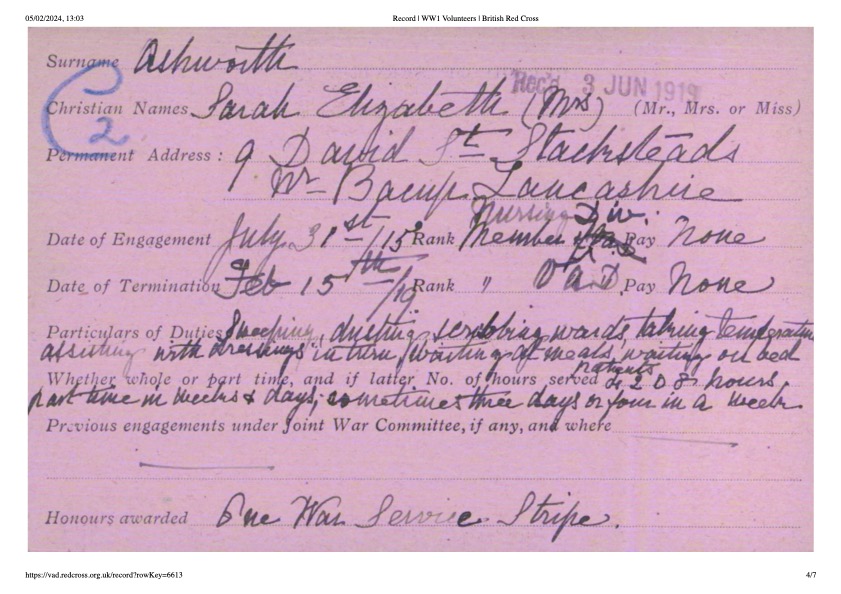
Sarah Ashworth from Stacksteads worked part-time as an unpaid volunteer at the New Hall Hey Military Hospital, Rawtenstall, Lancashire. Her duties involved sweeping, dusting, scubbing wards, taking temperatures, assisting with dressings, waiting at meals and waiting on bed patients. Awarded: One War Service Stripe.
New Hall Hey Military Hospital was located at New Hall Hey House in the centre of Rawtenstall. It opened in July 1915 with 18 beds. On 14th October 1916 a new ‘Kitchener Ward’ of 25 beds was added.
Local mills and businesses sponsored the beds: Green Bridge Mill, Myrtle Grove Mill, Sagarholme Mill, Whitwell Works, The Employees of Mitchell Bros (Waterfoot) Ltd, Lower Mill, Albion Mill, Hall Carr Mill, Spring and Isle of Man Mill (Water), Reedsholme Works and The Sir H W Trickett Ltd.
By the time it closed in 1919 capacity was 66 beds. Almost 700 patients were treated at the hospital. The site is now occupied by a roundabout and the Fire Station.
Lois Marsden
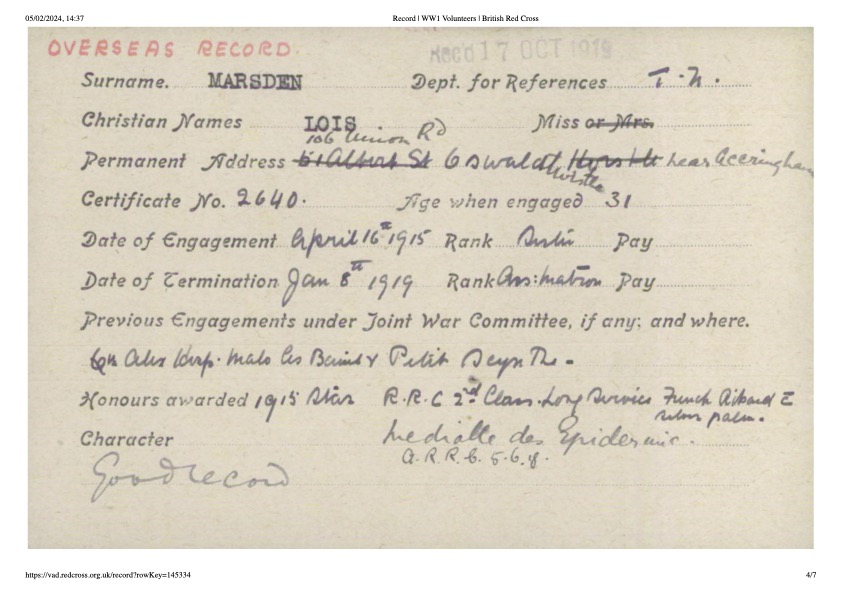
Lois Marsden from Oswaldtwistle was 31 years old when she volunteered for the Red Cross in April 1915. She was a Quaker and a nurse and joined the Friends Ambulance Unit (F.A.U.) caring for casualties at the 6th Auxillary Hospital, and the Queen Alexandra Hospital in Malo les Bains (mainly for Belgian casualties) & Petit Scynthe in Dunkirk until they could be evacuated on hospital ships. By the end of the war she was an Assistant Matron. Awarded: 1915 Star, Royal Red Cross 2nd Class, Long Service French Riband with Silver Palm, Médaille Des Épidémies, Associates Royal Red Cross in 5-6-18.
In March 1918 the town of Dunkirk and ships in its harbour were targeted with air raids and shelling from both a naval bombardment and long range German guns – the events are described in an extract below from the diary of Molly Evans, a VAD nurse in the Queen Alexandra Hospital.
“Air Raid began at about 8 pm as moon came up & we were preparing for bed. As shrapnel was bursting very near & ‘bits’ flying ‘through’ walls & roof, it compelled us to go to a ‘cellar’. Some heavy stuff dropped. Bitterly cold in cellar, everyone talking & reading papers & sketching ‘sketchy’ bits. 2 candles. Whenever anyone attempted to go up, ‘Zonc’ went the bombs & ‘Mournful Mary’ wailed in accompaniment to the blaring blast of the ‘Cow’ (sirens). This lasted till about midnight, when the low flying Hun took his humming infernal machines home to bed & we followed suite! only to be awakened again at 4 am by the most deafening explosions, screaming shells, brilliant flashes & terrific earth splitting noises & shattering ‘falls’ that shook us nearly out of bed. I sat up & said “Naval Bombardment, cellar no use”. Terrific & terrible shells upon shells shrieking over our heads.” 20-21 March 1918, diary of Molly Evans
On Saturday 23 Mar 1918 a decision was taken to evacuate the Queen Alexandra Hospital in Malo les Bains to the grounds of Château de Petite Synthe on the outskirts of Dunkirk.
Credit: Red Cross archives.
Voluntary Aid Detachments (VAD)
The Balkan Crisis of 1908 increased tensions in Europe and the following year the UK War Office asked the Red Cross and the Order of St John to form Voluntary Aid Detachments (VAD) in an effort to prevent the shortage of nurses in case of war. Each detachment was a hospital or medical station, sometimes established by local funding, which operated under the umbrella of the Red Cross.
VAD volunteers were required to work under fully trained nurses and had to be between 23 and 38 years of age. They were taught first aid, home nursing and hygiene, as well as classes in cookery. They practised in hospital wards and in many cases trained in infirmaries. Some refused to take a salary, and many highly skilled volunteers willingly worked at a low rate of pay.
By October 1910, over 2,500 detachments had been registered with over 6,000 volunteers. These numbers increased considerably after 1914 to over 74,000 volunteers, two-thirds of whom were women and girls. The majority of VADs worked on the home front.
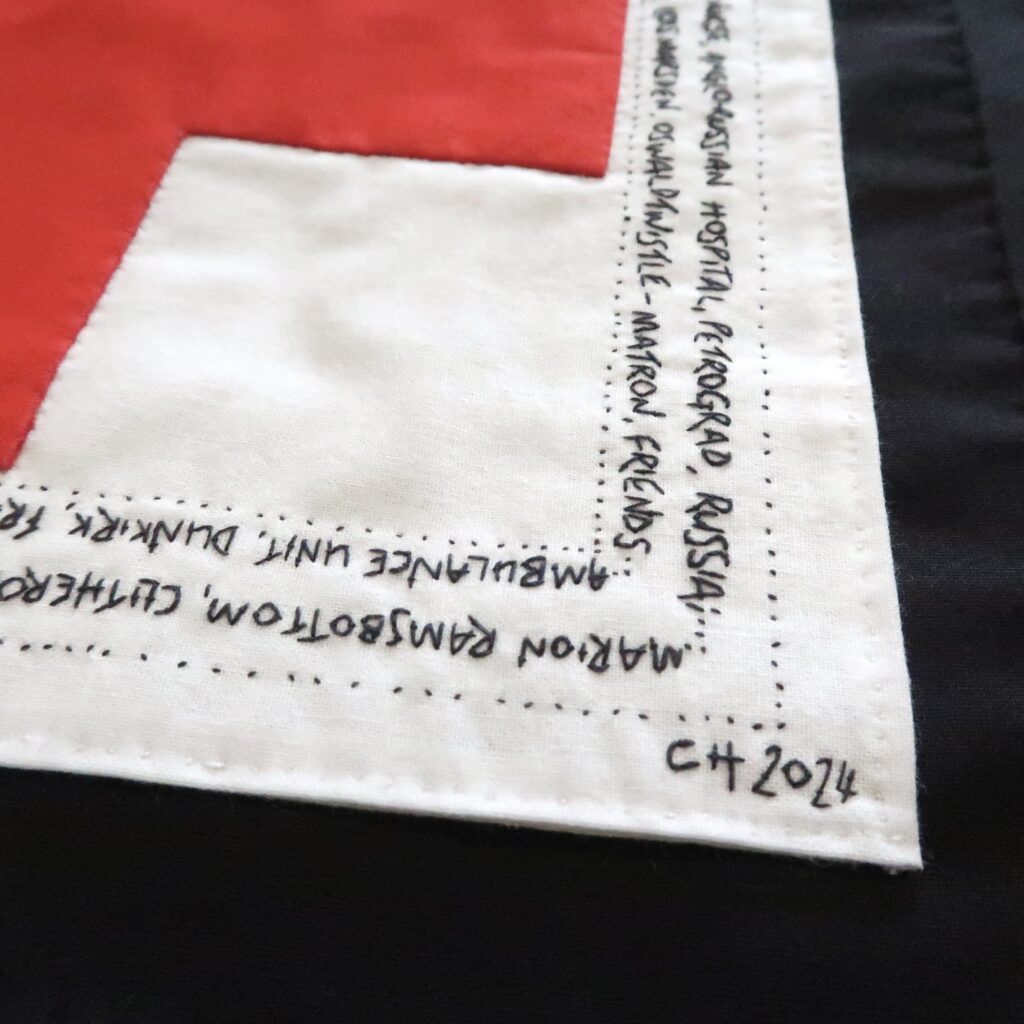
Through the course of the war there was an ever increasing need for VAD assistance overseas. They were posted to Belgium, Egypt, Malta, Salonika (Greece), Russia, Gallipoli, Mesopotamia, Serbia, Romania and Italy. Requests for VAD’s came from Military Hospitals, Royal Naval Hospitals, New Zealand hospitals, RAF hospitals, WRNS sick bays and QMAAC sick bays.
By 1916, around 8,000 trained nurses were employed in hospitals at home with around 126,000 beds. A further 4,000 nurses were working overseas with 93,000 beds.
By 1918 the number of VAD numbers overall had risen to about 80,000. 12,000 of these were nurses working in the military hospitals and 60,000 were unpaid volunteers working in auxiliary hospitals in a variety of roles such as ambulance drivers, cooks, cleaners and clerks.
Honours and awards
Throughout WW1 new awards were approved to acknowledge the service of VAD volunteers.
The Royal Red Cross (RRC) medal had been awarded since its creation in 1883. It was conferred on women within the nursing profession regardless of their rank. Most awards went to those who served in senior grades between ‘acting sister’ and ‘matron-in-chief’. In 1915 a new award, the ‘Associates’ Royal Red Cross medal (ARRC) was introduced.
VAD nurses were rewarded for their service with War Service bars or stripes to display on their uniform.
The Red Cross war medal was awarded to members of the Red Cross or its VADs who served in the UK between 4 August 1914 and 31 December 1919. The medal was introduced in 1920 and was awarded to some 41,000 members who had served in the United Kingdom.
In 1917 King George V approved the 1914 star, often referred to as the ‘Mons Star’, to all those officers and men of the British & Indian expeditionary forces. This included nurses who served in France or Belgium between 5 August 1914 and midnight on 22 November 1914.
In 1919 the King approved the issue of a clasp to those already awarded the 1914 star. It was awarded to those “who actually served under the fire of the enemy in France or Belgium” between 5 August and 22 November 1914. In total 365,622 1914 stars were awarded and 145,000 1914 star clasps.
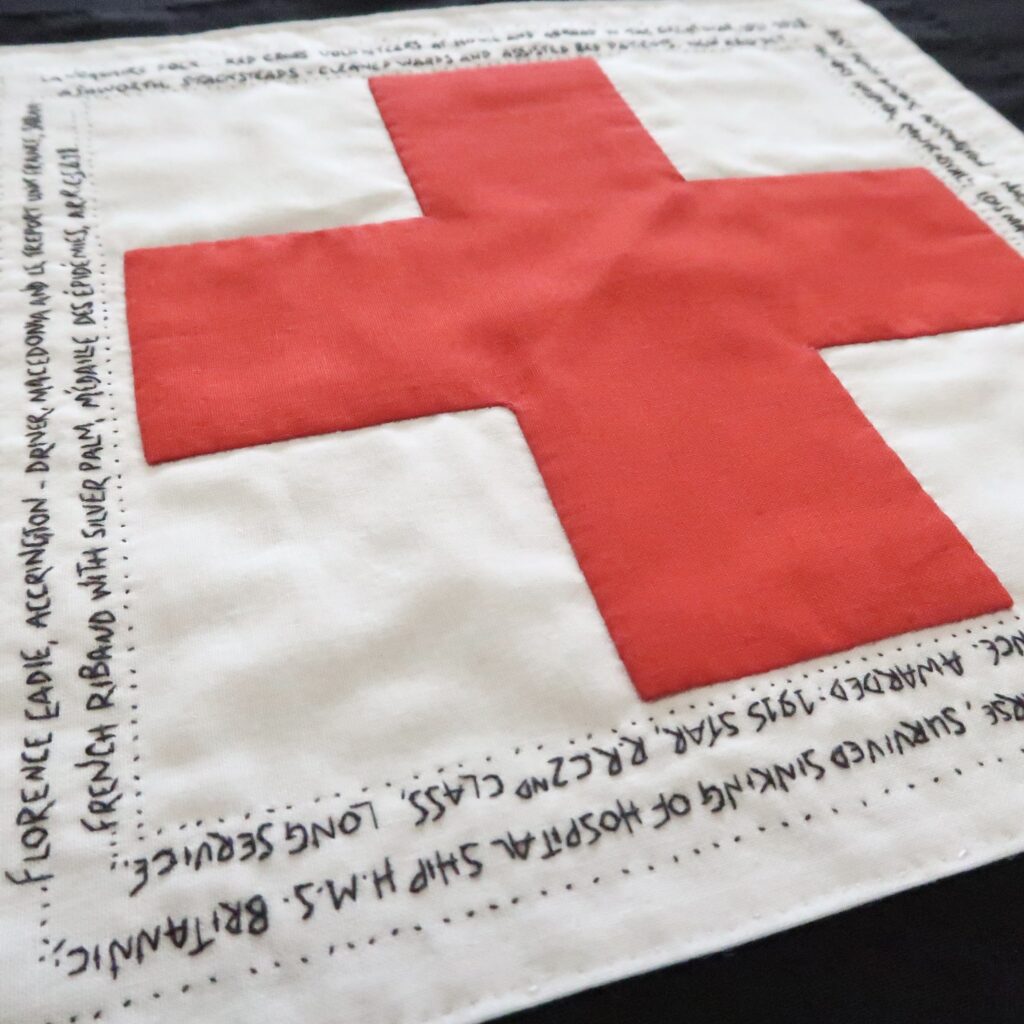
For further information on the movement of military casualties from the front line, please visit ‘The Long, Long Trail‘.
Update:
‘Blood Sweat & Tears’ is on its first stop touring Australia and will be on exhibition at the Sydney Craft & Quilt Fair, ICC Sydney Darling Harbour, Australia July 3 – 6, 2024.

Update:
‘Blood Sweat & Tears’ is on its second stop touring Australia and will be on exhibition at the Melbourne Craft & Quilt Fair, Melbourne Convention & Exhibition Centre, Melbourne, Australia, July 24 – 27, 2024.

Update:
‘Blood Sweat & Tears’ is on its third and final stop touring Australia and will be on exhibition at the Brisbane Craft & Quilt Fair, Brisbane Convention & Exhibition Centre, Brisbane, Australia, October 9 – 12, 2024.

